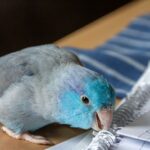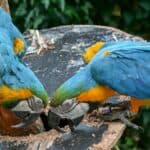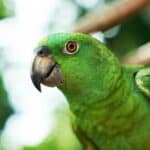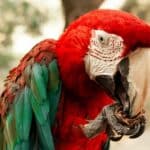Last Updated on January 28, 2024 by Carrie Stephens
Scissor beak in parrots (also called ‘crooked beak’ or ‘crossed beak’) occurs when the upper and lower beak grow sideways but in opposite directions, forming a scissor-like cross when closed.
Hatchlings can have scissor beak, suggesting that it’s caused by genetics or incubation conditions.
Parrots can also develop scissor beak in adulthood. This condition can be caused by a poor diet, insufficient enrichment, contagious diseases, injury, and neoplasia (tumors).
How Parrots Get Scissor Beak
Scissor beak is often discussed in conjunction with other beak conditions like elongation of the beak (overgrown beak) or ‘mandibular prognathism’ (underbite).
Scissor break – or lateral beak deviation – has several risk factors, including:
Genetics
Since many cases of scissor beak occur in baby parrots, genetics likely play a role.
Also, since certain parrot species (like macaws) are more vulnerable to the condition than others, this supports the notion that genetics is a significant factor.
According to Science Direct, many beak deformities are partly congenital (inherited). Other proven congenital diseases include familial cataracts and being born with tiny eyes.
Stressful Breeding Conditions
In a breeding experiment by Al Wibra Wildlife Preservation, the male Hyacinth Macaw used for breeding had a history of picking feathers due to stress.
Two of his offspring were born deformed (one with scissor beak and the other with a foot deformity).
This doesn’t prove that a stressed parrot is likelier to parent chicks with birth defects. However, it’s possible that stress could aggravate pre-existing genetic diseases.
This is how genes and the environment interact, causing scissor beak.
Incubation Problems
According to the MSD Manual, incubation faults can lead to scissor beak.
It’s okay to incubate eggs artificially, but breeders must have the right equipment. They must also maintain the optimal temperature and humidity settings.
Faulty equipment interferes with development, preventing chicks from growing healthy rostrums (beaks).
Hand-Feeding Method
If a baby parrot’s beak is wiped too hard or knocked when feeding, it could develop a scissor beak.
When a parrot is young, its beak is soft and malleable. According to Vet Exotic, a scissor beak can often be corrected by gently pressing it back into alignment a few times daily.
Malnutrition
According to Entomology Journal, ‘beak overgrowth’ can be caused by vitamin A deficiency.
Scissor beak isn’t quite the same as beak overgrowth, but it’s similar. A parrot could suffer from overgrowth and lateral (scissor) growth.
Vitamin A deficiencies are common in parrots fed a seed-only diet.
A lack of Vitamin D3 (synthesized through sun exposure) and a calcium deficiency (hypocalcemia) are also associated with beak overgrowth and scissor beak.
Infectious Diseases
Some diseases, including parasitic and mycobacterial infections, cause beak deformities. An NIH study explored the case of a parrot whose beak became deformed following a bacterial infection.
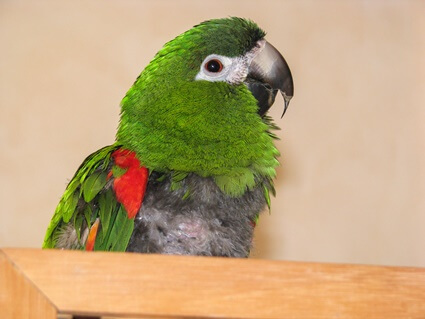
Trauma
Trauma to the beak is more common in the wild than in domestic settings. Nevertheless, a pet parrot can injure its beak by flying into a hard surface like a window or ceiling fan.
Blunt trauma can damage the top or bottom of the beak, causing a scissor-like deformity. According to Wiley Online, beak fractures are severe because the injured bird may be unable to eat.
Neoplasia
Neoplasia means tissue overgrowth, which could be cancerous or benign. If a tumor grows near the beak, it could become deformed and take on a scissor-like shape.
Lack of Enrichment
Parrots sharpen their beaks on wood and other surfaces, keeping them healthy. If you don’t provide a parrot with rough and abrasive surfaces, this can lead to beak overgrowth.
A paper by Alvefas argues that increasing a parrot’s enrichment (i.e., by providing types of wood to chew on) can improve beak health and minimize overgrowth.
Parrot Species Most Likely to Get Scissor Beak
The parrot family’s most vulnerable species are Macaws (Ara). Budgerigars sometimes get scissor beak, although beak overgrowth is more common.
Cockatoos (Cacatuidae) are also vulnerable to a similar beak deformity called mandibular prognathism.
While scissor beak forces the upper and lower beak sideways, mandibular prognathism is more like an underbite. Macaws can get mandibular prognathism, but it’s uncommon.
Parrots Living with Scissor Beak
A parrot uses its beak in the following ways:
- Preen.
- Climb.
- Hold onto perches.
- Regulate body temperature.
- Eat and drink.
- Line nests.
- Protect itself.
Although parrots’ day-to-day needs are met, they need a healthy beak to perform daily tasks. At its worst, a scissor beak can stop a parrot from eating food and hydrating.
Minor cases of scissor beak can be tolerated for a while, but the deformity will worsen if left untreated. Scissor beak could cause parrots to become withdrawn and apathetic.
Scissor Beak Treatment
Scissor beak treatment varies based on the parrot’s age and the severity of the deformity.
In hatchlings and juveniles, it’s sometimes possible to ‘mold’ the beak by realigning it after each meal. This must be done within 7 weeks because the beak’s keratin will harden.
A more invasive treatment is called transsinus pinning. Here, the upper and lower beak are pinned in place. An orthodontic rubber band provides tension, keeping the beak in place as it grows.
This three-week treatment is suitable for chicks under 16 weeks old. A trial by BioOne found that almost all of the 16 chicks tested were cured of scissor beak.
In adult parrots with advanced symptoms, it’s possible to use a dental composite to align the beak. The treatment isn’t invasive, so an anesthetic isn’t required.
Research Gate noted that getting results from a dental composite could take 3-6 months. You would also need to hand-feed the parrot during this period.
You can control the progression with regular beak trims if the beak isn’t overly crooked.
How To Trim A Scissor Beak
Depending on the parrot’s diet and lifestyle, trimming could be required every 3-12 months.
Trim the ends (not further up the beak) because this could damage the blood vessels and cause bleeding. A vet may trim the parrot’s beak using scissors, clippers, or a debeaking machine.
Preventing Scissor Beak
Here are some things that can be done to avoid scissor beak:
- Give the parrot some natural wood to chew on, like bamboo wood, elmwood, or apple tree wood.
- Feed the parrot a healthy diet. Include foods high in beta-carotene, like carrots and orange-fleshed melon, to avoid a vitamin A deficiency.
If you intend to get a juvenile parrot from a breeder, wait until it’s 8 weeks old. That way, its beak will have hardened, and you’ll be able to see if it’s properly aligned.
A vet can usually control scissor beak by identifying it early and performing regular trims.


